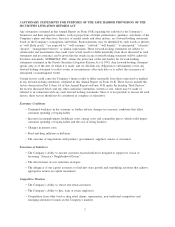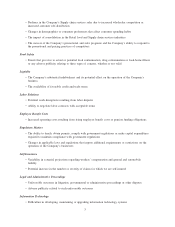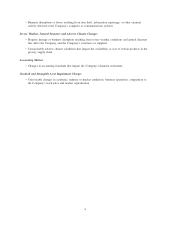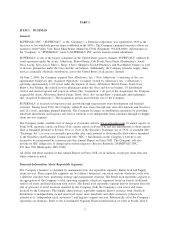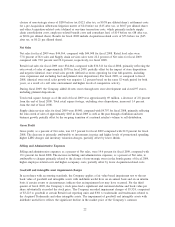Albertsons 2010 Annual Report Download - page 18
Download and view the complete annual report
Please find page 18 of the 2010 Albertsons annual report below. You can navigate through the pages in the report by either clicking on the pages listed below, or by using the keyword search tool below to find specific information within the annual report.Costs of employee benefits
The Company provides health benefits and sponsors defined pension and other post-retirement plans for
substantially all employees not participating in multi-employer health and pension plans. The Company’s costs
to provide such benefits continue to increase annually and recent legislative and private sector initiatives
regarding healthcare reform could result in significant changes to the U.S. healthcare system. The Company is
not able at this time to determine the impact that healthcare reform could have on the Company-sponsored
medical plans. In addition, the Company participates in various multi-employer health and pension plans for a
majority of its union-affiliated employees, and the Company is required to make contributions to these plans
in amounts established under collective bargaining agreements. The costs of providing benefits through such
plans have escalated rapidly in recent years. The amount of any increase or decrease in the Company’s
required contributions to these multi-employer plans will depend upon many factors, including the outcome of
collective bargaining, actions taken by trustees who manage the plans, government regulations, the actual
return on assets held in the plans and the potential payment of a withdrawal liability if the Company chooses
to exit a market. Increases in the costs of benefits under these plans coupled with adverse stock market
developments that have reduced the return on plan assets have caused some multi-employer plans in which the
Company participates to be underfunded. The unfunded liabilities of these plans may result in increased future
payments by the Company and the other participating employers, including costs that may arise with respect
to any potential litigation or that may cause the acceleration of payments to fund any underfunded plan. The
Company’s risk of such increased payments may be greater if any of the participating employers in these
underfunded plans withdraws from the plan due to insolvency and is not able to contribute an amount
sufficient to fund the unfunded liabilities associated with its participants in the plan. If the Company is unable
to control healthcare and pension costs, the Company may experience increased operating costs, which may
adversely affect the Company’s financial condition and results of operations.
Governmental regulations
The Company’s businesses are subject to various federal, state and local laws, regulations and administrative
practices. These laws require the Company to comply with numerous provisions regulating health and
sanitation standards, equal employment opportunity, minimum wages and licensing for the sale of food, drugs
and alcoholic beverages. The Company’s inability to timely obtain permits, comply with government
regulations or make capital expenditures required to maintain compliance with governmental regulations may
adversely impact the Company’s business operations and prospects for future growth and our ability to
participate in federal and state healthcare programs. In addition, the Company cannot predict the nature of
future laws, regulations, interpretations or applications, nor can the Company determine the effect that
additional governmental regulations or administrative orders, when and if promulgated, or disparate federal,
state and local regulatory schemes would have on the Company’s future business. They may, however, impose
additional requirements or restrictions on the products the Company sells or manner in which the Company
operates its businesses. Any or all of such requirements may adversely affect the Company’s financial
condition and results of operations.
Insurance claims
The Company uses a combination of insurance and self-insurance to provide for potential liabilities for
workers’ compensation, automobile and general liability, property insurance and employee healthcare benefits.
The Company estimates the liabilities associated with the risks retained by the Company, in part, by
considering historical claims experience, demographic and severity factors and other actuarial assumptions
which, by their nature, are subject to a degree of variability. Any actuarial projection of losses concerning
workers’ compensation and general and automobile liability is subject to a degree of variability. Among the
causes of this variability are unpredictable external factors affecting future inflation rates, discount rates,
litigation trends, legal interpretations, benefit level changes and actual claim settlement patterns.
Some of the many sources of uncertainty in the Company’s reserve estimates include changes in benefit levels,
medical fee schedules, medical utilization guidelines, vocation rehabilitation and apportionment. If the number
12


